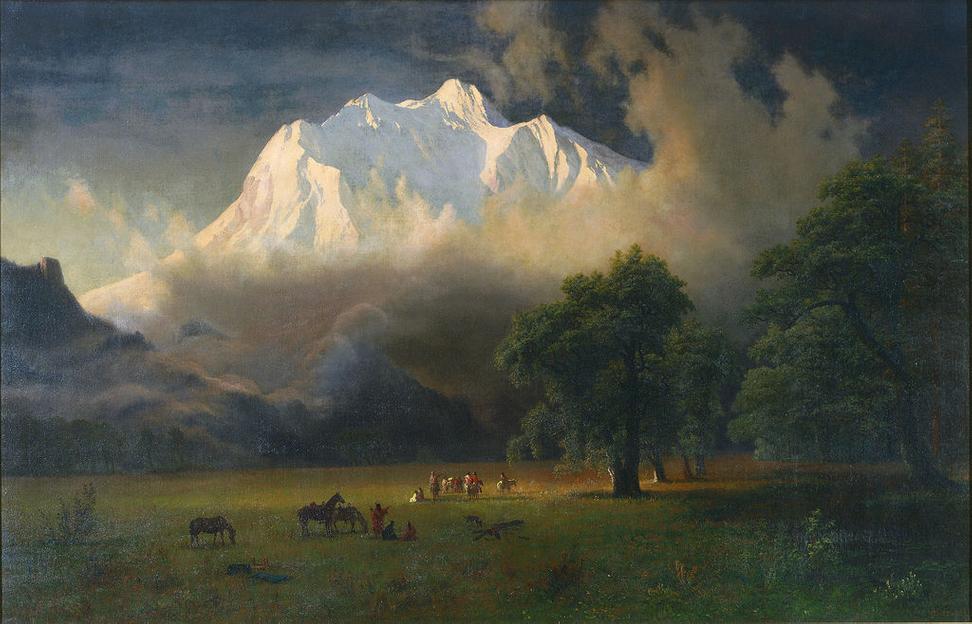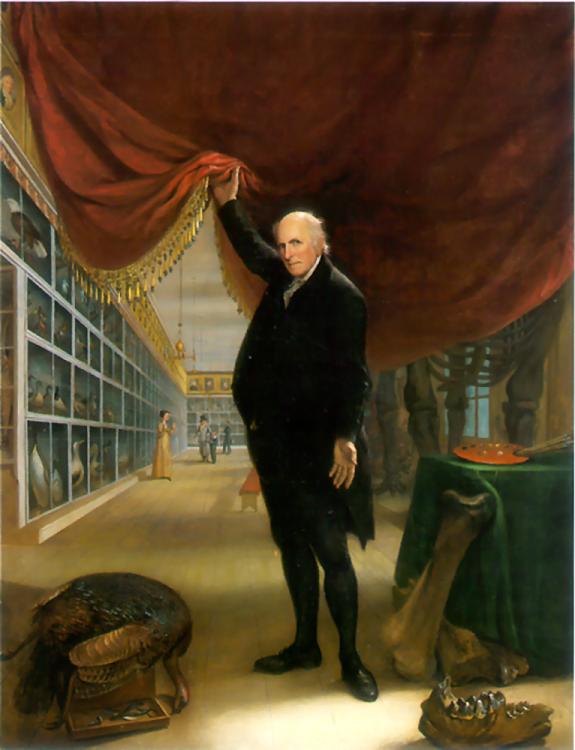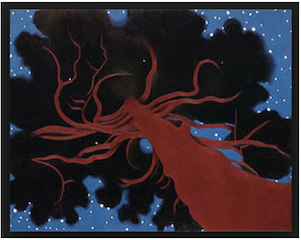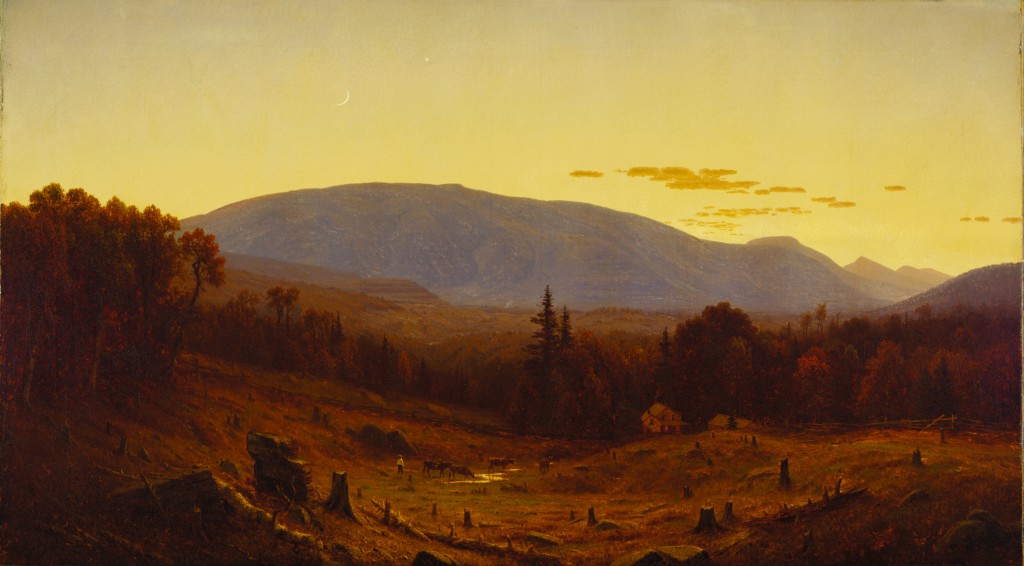Oct. 13, 2018-Jan. 6, 2019
Peabody Essex Museum in Salem, Massachusetts
Feb. 2-May 5, 2019
Crystal Bridges Museum of American Art in Bentonville, Arkansas
May 25–Sept. 9, 2019

Albert Bierstadt, American, 1830–1902, Mount Adams, Washington, 1875. Oil on canvas. Gift of Mrs. Jacob N. Beam.(Princeton University Art Museum)
This fall, the story of our changing relationship with the natural world will be comprehensively told through a groundbreaking exhibition encompassing three centuries of American art. Nature’s Nation: American Art and Environment presents more than 120 paintings, sculptures, prints, drawings, photographs, videos and works of decorative art, from the colonial period to the present, exploring for the first time how American artists of different traditions and backgrounds have both reflected and shaped environmental understanding while contributing to the development of a modern ecological consciousness.
This sweeping exhibition engages a wide range of genres and historical contexts – from colonial furniture to the art of Jeffersonian natural science, from Hudson River landscape painting to Native American basketry, from Dust Bowl regionalism to modernist abstraction and postwar environmental activism – highlighting the evolving ecological implications of subjects and contexts of creation as well as artistic materials and techniques. The result is a major reinterpretation of American art that examines both iconic masterpieces and rarely seen objects through a lens uniting art historical interpretation with environmental history, scientific analysis and the dynamic field of ecocriticism.
“Nature’s Nation advances a new approach to understanding and interpreting American art of the past three centuries, opening up rich avenues of engagement with both celebrated and less familiar works of art,” said James Steward, Nancy A. Nasher–David J. Haemisegger, Class of 1976, director. “At a time when the question of our relationship with the natural world is so much on our minds, Nature’s Nation positions the museum as a crucial site for close looking, conversation and exchange on questions that matter both to our identities as Americans and to our future.”
The exhibition is the culmination of years of innovative research by co-curators Karl Kusserow, the John Wilmerding Curator of American Art at the Princeton University Art Museum, and Alan C. Braddock, the Ralph H. Wark Associate Professor of Art History and American Studies at William & Mary. To help rethink American art history in environmental terms, they have selected works by more than 100 artists, including John James Audubon, George Bellows, Albert Bierstadt, Frederic Edwin Church, Thomas Cole, Thomas Eakins, Theaster Gates, Winslow Homer, Louisa Keyser, Dorothea Lange, Ana Mendieta, Thomas Moran, Isamu Noguchi, Georgia O’Keeffe, Maya Lin, Frederick Law Olmsted, Charles Willson Peale, Jackson Pollock, Robert Rauschenberg, Alexis Rockman, Robert Smithson, Carleton Watkins and Andrew Wyeth.
Nature’s Nation begins with an introductory gallery, where iconic paintings by

Albert Bierstadt (Bridal Veil Falls, Yosemite, ca. 1871-73)

and Thomas Moran (Lower Falls, Yellowstone Park, 1893) are displayed alongside works by Valerie Hegarty (Fallen Bierstadt, 2007) and Jaune Quick-to-See Smith (Browning of America, 2000) that revise and complicate earlier perceptions of the pristine American environment. The fifteen diverse works in the introduction set the stage for the following sections, which together reveal our evolving sense of what nature means and how we as humans relate to it.
The first, Colonization and Empire, focuses on images of the young Republic’s ideas about natural order, as seen in
![C W Peale - The Artist in His Museum.jpg]()
Charles Willson Peale’s renowned The Artist in His Museum (1822), before exploring picturesque and sublime representations of the land in paintings such as
![File:Home in the Woods 1847 Thomas Cole.jpeg]()
Thomas Cole’s Home in the Woods (1847), and Americans’ plans for nature’s transformation, as in Frederick Law Olmsted’s enormous Central Park “Greensward Plan” (1858).

Charles Willson Peale’s renowned The Artist in His Museum (1822), before exploring picturesque and sublime representations of the land in paintings such as

Thomas Cole’s Home in the Woods (1847), and Americans’ plans for nature’s transformation, as in Frederick Law Olmsted’s enormous Central Park “Greensward Plan” (1858).
A second section, Industrialization and Conservation, explores work that addresses the tensions between progress and preservation, including complex representations of consumption and its effects by
![Image result]()
Winslow Homer (Prisoners from the Front, 1866),
![Anschutz Thomas P The Ironworker-s Noontime.jpg]()
Thomas Anshutz (The Ironworker’s Noontime, 1880) and a Standing Rock Sioux artist (a stretched buffalo robe of 1882).

Winslow Homer (Prisoners from the Front, 1866),

Thomas Anshutz (The Ironworker’s Noontime, 1880) and a Standing Rock Sioux artist (a stretched buffalo robe of 1882).
Finally, Ecology and Environmentalism considers art of the 20th and 21st centuries that reimagines ecology on a global scale through expansive techniques and media. Among the works featured are
![upright=y]()
Georgia O’Keeffe’s iconic The Lawrence Tree (1929) and Robert Rauschenberg’s lithographic collage announcing the first Earth Day (1970).

Georgia O’Keeffe’s iconic The Lawrence Tree (1929) and Robert Rauschenberg’s lithographic collage announcing the first Earth Day (1970).
“The Museum is grateful to the many institutions and funders who enthusiastically supported this innovative new vision of North American history and culture,” Steward said. Lenders include 70 eminent national collections, both private and public, as well as works drawn from Princeton’s extensive holdings.

Sanford Robinson Gifford, Hunter Mountain, Twilight, 1866. Terra Foundation for American Art, Daniel J. Terra Collection, 1999.57
The exhibition traces evolving ideas about the environment – and our place within it – from colonial beliefs about natural theology and biblical dominion through the 19th-century notion of manifest destiny to the emergence of modern ecological ethics. This pioneering exhibition will gather approximately 125 works of art by a broad range of artists – including iconic masterpieces as well as rare and seldom exhibited works – and interpret them through an interdisciplinary lens that unites art and environmental history with scientific analysis, using ecocriticism as a tool to see the history of American art in a new light.
Organized by the Princeton University Art Museum, the exhibition is cocurated by Karl Kusserow, John Wilmerding curator of American art at the Princeton University Art Museum; and Alan C. Braddock, Ralph H. Wark associate professor of art history and American studies at the College of William and Mary.
Nature’s Nation will consist of paintings, sculptures, prints, drawings, photographs, videos and works of decorative art gathered from more than 70 eminent collections across the United States as well as from Princeton’s own extensive holdings. The exhibition will be arranged in three chronological eras marked by shifting human conceptions of the natural world and increasing artistic awareness of environmental change.
Among the more than 100 artists featured in the exhibition will be John James Audubon, George Bellows, Albert Bierstadt, Frederic Edwin Church, Thomas Cole, Thomas Eakins, Theaster Gates, Winslow Homer, Louisa Keyser, Dorothea Lange, Ana Mendieta, Thomas Moran, Isamu Noguchi, Georgia O’Keeffe, Frederick Law Olmsted, Charles Willson Peale, Sarah Miriam Peale, Jackson Pollock, Robert Rauschenberg, Alexis Rockman, Robert Smithson and Carleton Watkins.

A major 448-page catalogue, published by the Princeton University Art Museum and distributed by Yale University Press, accompanies the exhibition. In addition to a series of expansive narrative essays by the curators, the publication features contributions by 13 distinguished scholars and artists in a variety of fields, including art historians Rachael DeLue and Robin Kelsey, artists Mark Dion and Jaune Quick-to-See Smith, and environmental theorists Timothy Morton and Rob Nixon.